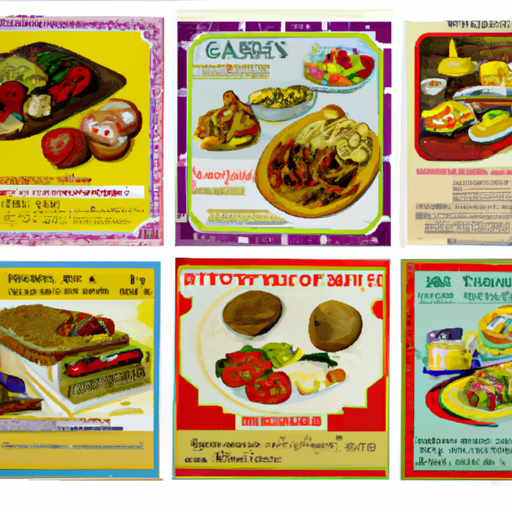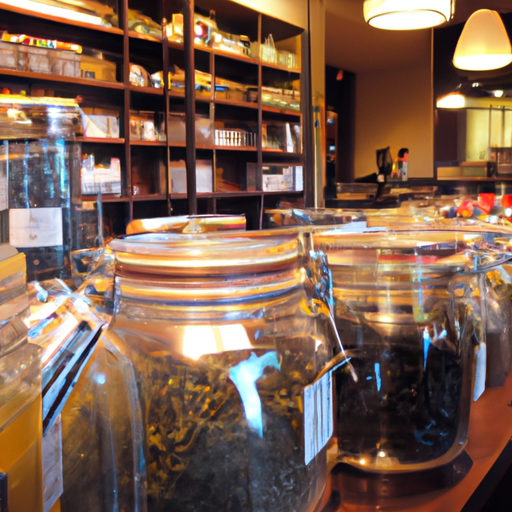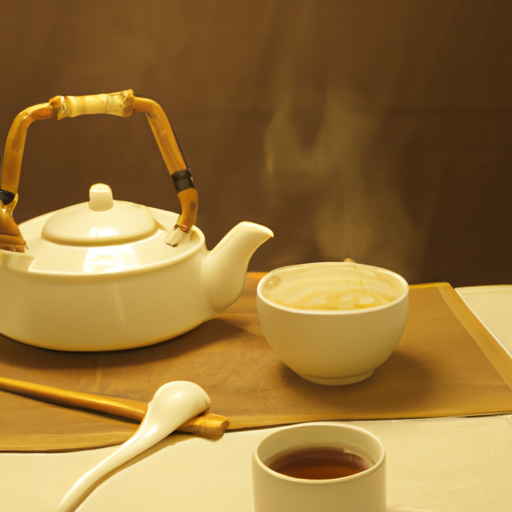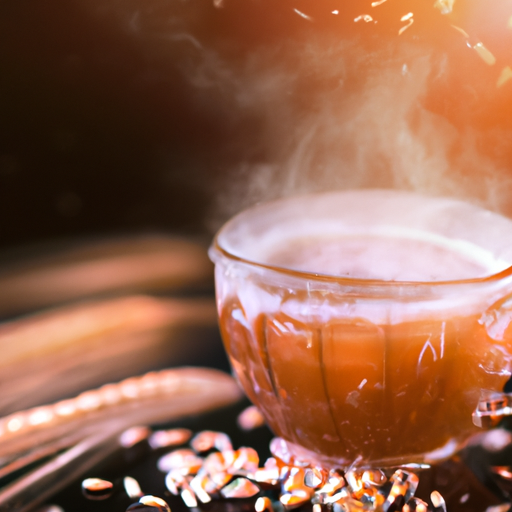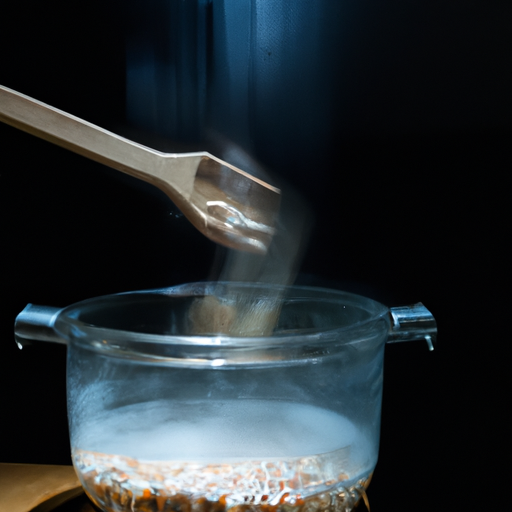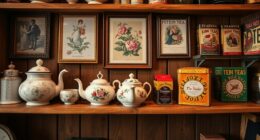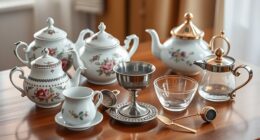I truly love the flavor of roasted barley tea. The delightful, nutty scent that envelops my kitchen while I’m making it is just so appetizing. As for the flavor? It’s utterly heavenly.
If you’ve never tried it before, you’re in for a real treat. Trust me, this is the kind of drink that will have you coming back for more.
In this article, I’m going to show you how to make roasted barley tea from scratch. It’s a simple process that requires just a few ingredients and a little bit of patience. But believe me when I say that the end result is more than worth it.
Not only is roasted barley tea delicious, but it’s also incredibly healthy. So, let’s get started!
Key Takeaways
- Roasted barley tea aids in digestion, reduces inflammation, lowers blood pressure and cholesterol levels, and contains antioxidants that protect against oxidative stress.
- To make roasted barley tea, you need roasted barley, filtered/purified water, and a tea strainer. Barley should be washed and soaked in cold water before roasting using various techniques.
- Roasted barley tea can be served hot or cold and paired with different flavors such as honey, lemon, ginger, mint, and cinnamon.
- The tea has cultural significance in Korea, where it is served as a refreshing and caffeine-free alternative to water during meals and as a gesture of hospitality to guests. It is gaining popularity globally and is found in different variations in Japan and China, complementing a variety of dishes.
Health Benefits of Roasted Barley Tea
You’ll be surprised at the amazing health benefits you can enjoy from sipping on a cup of delicious roasted barley tea! Roasted barley tea, or mugicha, is a popular beverage in Asia that’s been enjoyed for centuries. Not only is it refreshing and tasty, but it’s also packed with numerous health benefits.
One of the benefits of drinking roasted barley tea is that it aids in digestion. Scientific research has shown that drinking mugicha can help promote the growth of good bacteria in your gut, which can improve digestion and prevent constipation. Additionally, it’s been found to reduce inflammation in the digestive system, which can alleviate symptoms of conditions such as irritable bowel syndrome.
Roasted barley tea is also a great choice for those looking to improve their heart health. Drinking this tea has been shown to lower blood pressure and cholesterol levels, which can reduce the risk of heart disease. It also contains antioxidants that can help protect against oxidative stress, which is a major contributor to heart disease and other chronic conditions.
To make this healthy and delicious tea, you only need a few simple ingredients. All you need is roasted barley, water, and a tea bag or strainer. So, let’s get started by gathering these ingredients and brewing a cup of this amazing tea!
Ingredients You Will Need
Grab the essentials for this wholesome and refreshing beverage, including a few items you may already have in your pantry. To make roasted barley tea, you’ll need roasted barley, water, and a tea strainer.
Roasted barley can be found at your local grocery store or online. It has a nutty, toasty flavor profile that adds depth to the tea’s taste. It’s also packed with nutritional value, containing minerals such as calcium, magnesium, and potassium.
The water used to make roasted barley tea should be filtered or purified. It’s important to use clean water because it’ll affect the overall taste of the tea.
The tea strainer will be used to filter out the roasted barley bits from the tea. A fine mesh strainer or cheesecloth can also be used if a tea strainer isn’t available.
With just these three ingredients, you can make a delicious, healthy beverage that’s perfect for any time of day.
Next up, we’ll discuss the equipment you’ll need to prepare this refreshing drink.
Equipment You Will Need
To prepare this wholesome and refreshing beverage, all you need is some equipment that you likely already have in your kitchen. First and foremost, you will need a teapot. There are various types of teapots available in the market, including ceramic, glass, and stainless steel. Ceramic teapots are ideal for brewing roasted barley tea as they retain heat well. However, glass teapots are great if you want to watch the tea steeping process. On the other hand, stainless steel teapots are durable and have a sleek appearance.
Another essential piece of equipment is a strainer. A fine mesh strainer is perfect for removing any small particles from the tea. It is important to remove these particles to ensure that the tea has a smooth texture and is free of any debris. Additionally, you will need a measuring cup to measure the amount of water you use. The amount of water you use is important because it can affect the flavor of the tea.
Lastly, the quality of water used to make roasted barley tea is crucial. It is recommended to use filtered or spring water as it can enhance the flavor of the tea. Tap water may contain impurities that can alter the taste of the tea. Therefore, it is important to use the right type of water to ensure that the roasted barley tea has a rich, full taste. Now that you have all the necessary equipment, let’s move on to preparing the barley.
Preparing the barley is a simple process that requires a few steps.
Preparing the Barley
First, I wash the barley thoroughly to remove any dirt or debris.
Then, I roast the barley in a dry pan over medium heat until it turns a light brown color and begins to give off a nutty aroma.
Roasting the barley enhances its flavor and aroma, giving the tea a rich and toasty taste.
Washing the Barley
Before you begin, remember that cleanliness is next to godliness, so make sure to thoroughly rinse the barley in cold water to remove any dirt or impurities. The type of barley you choose to use can also affect the flavor of your tea. There are various barley varieties available, such as hulled, pearled, and pot. You can experiment with different types to find the one that suits your taste buds the best.
Once you’ve chosen your preferred barley variety, it’s time to wash it. Start by placing the barley in a colander and running it under cold water for a few minutes. Make sure to rub the grains between your fingers to remove any dirt or dust particles. After washing, soak the barley in cold water for at least 30 minutes to soften it up. This will help the barley release its flavor during the roasting process.
Now that the barley is clean and soaked, it’s time to move on to the next step of roasting it.
Roasting the Barley
Now that you’ve cleaned and soaked the barley, it’s time to start roasting it to bring out its unique nutty flavor and aroma. Roasting techniques can vary depending on personal preference and the desired flavor profile.
Here are four techniques to consider:
-
Oven roasting – Preheat your oven to 350°F and spread the soaked barley on a baking sheet. Roast for 20-30 minutes, stirring occasionally, until the barley turns a rich golden color.
-
Stovetop roasting – Heat a dry skillet over medium heat and add the soaked barley. Stir constantly for 10-15 minutes until the barley turns a rich golden color.
-
Microwave roasting – Spread the soaked barley on a microwave-safe plate and microwave for 5-7 minutes, stirring every minute until the barley turns a rich golden color.
-
Popcorn maker roasting – Place the soaked barley in the popcorn maker and follow the machine’s instructions until the barley turns a rich golden color.
Roasting the barley is an important step in making roasted barley tea as it brings out the nutty, toasty flavor of the barley. Once the barley is roasted to your desired level, it’s time to move on to the next step of brewing the tea.
Brewing the Tea
To brew the tea, all you gotta do is throw some roasted barley in boiling water and let it steep until the flavor is so strong it could knock your socks off. But to really elevate the experience, I’ve got some brewing tips and flavor options to share with you. First off, let’s talk about the water. Use filtered water or spring water for the best taste. Tap water can have impurities that can affect the flavor. Next, consider the temperature of the water. Boiling water is fine, but if you want a milder taste, let the water cool down for a few minutes before pouring it over the roasted barley.
Now onto the fun part: flavor options! While traditional roasted barley tea is delicious on its own, you can add some variety by adding different ingredients to the brew. Check out the table below for some ideas:
| Flavor Option | Ingredients |
|---|---|
| Honey | Add a spoonful of honey for a touch of sweetness |
| Lemon | Squeeze some lemon juice into the tea for a citrusy kick |
| Ginger | Add a few slices of fresh ginger for a spicy twist |
| Mint | Drop in a few mint leaves for a refreshing taste |
| Cinnamon | Sprinkle in some cinnamon for a cozy, warming flavor |
So go ahead and experiment with different flavor combinations to find your perfect cup of roasted barley tea. And speaking of cups, in the next section we’ll talk about serving the tea and some fun ways to enjoy it.
Serving the Tea
When it comes to serving roasted barley tea, there are a few key decisions to make. First and foremost, do you prefer it hot or cold? Personally, I enjoy it both ways depending on the weather and my mood.
Next, consider whether or not you want to add any sweeteners or milk to your tea. I typically drink it plain, but a touch of honey or a splash of milk can add a nice flavor dimension.
Finally, think about pairing your tea with food. Its nutty, toasty flavor profile pairs well with savory snacks like roasted nuts or cheese, but it can also be a refreshing drink to enjoy alongside a sweet dessert.
Hot or Cold
Whether you prefer it hot or cold, roasted barley tea is a refreshing and healthy beverage that can be enjoyed year-round. As I mentioned in the previous subtopic, the benefits of drinking barley tea are numerous. It’s packed with antioxidants, vitamins, and minerals that can boost your immune system, aid digestion, and even promote weight loss. Additionally, there are different types of barley tea to choose from, such as traditional roasted barley, green barley, and even barley mixed with other herbs like ginger or mint.
To enjoy roasted barley tea, it’s important to serve it at the right temperature. Here’s a simple table to help you decide whether you want your tea hot or cold:
| Temperature | Serving Style | Description |
|---|---|---|
| Hot | Steaming | Perfect for cold winter days or when you need a comforting drink. |
| Cold | Over Ice | Great for hot summer days or as a refreshing post-workout drink. |
| Room Temperature | Chilled | A middle ground option that’s suitable for any time of the year. |
Now that you know how to serve your roasted barley tea, let’s move on to the next subtopic about sweeteners and milk.
Sweeteners and Milk
Indulge in the creamy goodness of your favorite milk and sweeteners to enhance the flavor of this healthy beverage. Adding a sweetener to roasted barley tea is a personal preference, but it can enhance the taste and aroma of the tea.
Some popular sweetener options include honey, sugar, and stevia. Honey adds a natural sweetness and also has antibacterial and anti-inflammatory properties. Sugar is a common sweetener, but it can be high in calories. Stevia, on the other hand, is a natural sweetener that is low in calories and has a higher sweetness level compared to sugar.
If you prefer to add milk to your roasted barley tea, there are also plenty of milk alternatives available. Almond milk, oat milk, and coconut milk are popular choices. Almond milk has a nutty flavor and a creamy texture, while oat milk has a slightly sweet taste and a thicker consistency. Coconut milk adds a tropical twist to the tea and has a rich and creamy flavor.
The addition of milk can also make the tea creamier and smoother, making it a perfect beverage for a cozy night in. Adding sweeteners and milk alternatives can give your roasted barley tea a delightful flavor and texture. It can also be a great option to pair with food, as the tea’s mild and nutty taste can complement a variety of dishes.
Pairing with Food
You might be hesitant to pair your favorite foods with roasted barley tea, but trust me, adding this healthy beverage to your meal can elevate its flavors and provide a refreshing balance to your palate.
Roasted barley tea has a nutty and slightly bitter taste that complements many different types of food. It goes well with grilled meats, seafood, and vegetables, and can also be enjoyed with snacks such as nuts, popcorn, or crackers.
When it comes to food pairings, it’s important to consider the flavor profiles of both the tea and the dish. For example, if you’re having a spicy dish, the nuttiness of the roasted barley tea can help to tone down the heat. On the other hand, if you’re having a sweet dessert, the slight bitterness of the tea can provide a nice contrast and prevent the dish from becoming overly saccharine.
So, don’t be afraid to experiment with different food pairings and discover the many ways in which roasted barley tea can enhance your meals.
Speaking of enhancing, storing your roasted barley tea properly can ensure that it maintains its flavor and freshness.
Storing the Tea
To keep your roasted barley tea fresh and flavorful, store it in an airtight container away from light and heat. This will help maintain its quality and prolong its shelf life. Here are some storage tips to ensure your tea stays fresh:
- Keep the tea in a cool, dry place. Exposure to heat and humidity can cause the tea to spoil and lose its flavor.
- Store the tea in an opaque container. Light can also affect the quality of the tea, so it’s best to keep it in a container that blocks out light.
- Avoid storing the tea near strong-smelling foods or spices. Tea can easily absorb odors, which can affect its taste and aroma.
By following these simple storage tips, you can enjoy your roasted barley tea for a longer period of time.
Now, let’s move on to exploring some variations on the recipe.
Variations on the Recipe
Let’s spice things up by trying out some different flavors in our homemade brew! Roasted barley tea is a versatile drink that can be enjoyed in a variety of ways.
One easy way to add some flavor to your roasted barley tea is to add some fresh lemon or lime juice. This will give your tea a tangy kick that is both refreshing and delicious. You can also experiment with adding different herbs and spices, such as ginger, mint, or cinnamon.
Another way to add some flavor to your roasted barley tea is to sweeten it with honey or agave nectar. This will give your tea a touch of sweetness without adding any artificial flavors or colors. If you prefer a more intense flavor, you can also try adding some fruit juice, such as apple or grape, to your tea. This will give your tea a fruity twist that is perfect for hot summer days.
It’s important to keep in mind that adding different flavors to your roasted barley tea may also affect the caffeine content. For example, adding citrus juice or fruit juice may decrease the caffeine content, while adding ginger or cinnamon may increase it. If you’re sensitive to caffeine, it’s a good idea to experiment with different flavor variations to find the ones that work best for you.
Now that we’ve explored some flavor variations, let’s dive into the cultural significance of roasted barley tea.
Cultural Significance of Roasted Barley Tea
Did you know that in Korea, roasted barley tea is often served as a refreshing and caffeine-free alternative to water during meals? This traditional beverage has a rich cultural significance that dates back centuries.
In Korean households, barley tea is a staple drink that is served cold during the summer months and hot during the winter months. The history and traditions surrounding roasted barley tea are fascinating.
In Korea, it is believed that barley tea has a cooling effect on the body and helps to prevent heat stroke. It is also said to aid in digestion and promote overall health. In addition to its health benefits, barley tea is deeply ingrained in Korean culture and is often served as a gesture of hospitality to guests.
Roasted barley tea has gained global popularity in recent years, and it is now enjoyed in many countries around the world. While the basic recipe remains the same, variations on the recipe can be found in different regions.
For example, in Japan, roasted corn is often added to the tea to give it a slightly sweet and nutty flavor. In China, the tea is sometimes flavored with chrysanthemum or jasmine flowers. Roasted barley tea is more than just a refreshing beverage.
It is a symbol of cultural traditions and hospitality in Korea, and its popularity continues to grow around the world. Whether served hot or cold, variations on the basic recipe can be found in different regions, each with its own unique flavor and history.
So the next time you enjoy a cup of roasted barley tea, take a moment to appreciate the rich cultural significance that this simple drink holds.
Frequently Asked Questions
Can roasted barley tea be made with other types of barley?
When it comes to making roasted barley tea, the type of barley used can make a big difference. While roasted barley is the traditional choice for this type of tea, other barley varieties can be used as well. Different types of barley will impart different flavors and aromas to the tea, so it’s worth experimenting to find the right one for your taste.
As for brewing methods, there are many different ways to make roasted barley tea, from steeping the roasted barley in hot water to simmering it on the stove. The key is to find a method that brings out the best flavors and aromas in the barley, so don’t be afraid to try different techniques until you find the one that works best for you.
Overall, making roasted barley tea with different barley varieties is a great way to experiment with different flavors and aromas, and it’s a fun way to explore the world of tea.
How long does it take to roast barley for tea?
Oh, roasting barley for tea is delightful! It only takes 20-30 minutes to transform those little grains into a toasty, nutty delight. Your preferred level of roastiness will determine the duration. Personally, I like a lighter roast for a delicate flavor profile. However, some may prefer a richer roast. Regardless, the roasting process is crucial in developing the unique flavor that makes barley tea beloved. Who knew such a simple ingredient could create such a delicious beverage?
And who knew such a simple ingredient could create such a delicious beverage?
Can roasted barley tea be made with cold water?
Yes, roasted barley tea can be made with the cold water method. This method involves adding roasted barley to cold water and letting it steep for several hours or overnight in the refrigerator.
The benefit of this method is that it produces a milder, smoother flavor than when using hot water. Drinking roasted barley tea has several benefits, including aiding in digestion, reducing inflammation, and helping to lower cholesterol levels.
It also contains antioxidants that can help to protect against disease. Overall, drinking roasted barley tea is a delicious and healthy way to support your overall well-being.
Can roasted barley tea be sweetened with honey or sugar?
Yes, roasted barley tea can definitely be sweetened with honey or sugar. In fact, adding a touch of sweetness can enhance the flavor of the tea and make it more enjoyable to drink.
When it comes to sweetening options, honey is a great choice as it not only adds sweetness but also has numerous health benefits. Honey is known to have antibacterial properties, can soothe a sore throat, and is a natural energy booster.
However, if you prefer sugar, that works too. Just keep in mind that too much sugar can have negative effects on your health.
Overall, adding a bit of sweetness to your roasted barley tea is a great way to enjoy its health benefits while also satisfying your taste buds.
Can roasted barley tea be consumed by people with gluten intolerance?
As someone with gluten intolerance, I understand the importance of finding gluten-free alternatives to many foods and beverages. When it comes to roasted barley tea, it’s important to note that barley does contain gluten, so it may not be a suitable option for those with gluten intolerance.
However, there are many other delicious and healthy teas that are gluten-free and can provide similar health benefits. Some great options include green tea, peppermint tea, and chamomile tea. These teas are rich in antioxidants and can help with digestion, relaxation, and stress relief.
So while roasted barley tea may not be a viable option for those with gluten intolerance, there are plenty of other teas to enjoy.
Conclusion
After learning about the health benefits and cultural significance of roasted barley tea, I decided to give it a try. The process was simple and the result was a delicious and refreshing drink that I plan on making a regular part of my routine.
But what struck me the most was how this simple beverage has been enjoyed for centuries and holds such importance in various cultures. It reminded me that sometimes the simplest things can have the most profound impact on our lives.
So next time you’re looking for a healthy and flavorful alternative to your usual drink, consider giving roasted barley tea a chance. Who knows, it may just become your new favorite.


